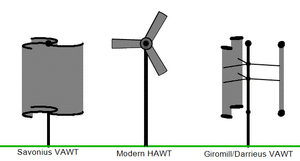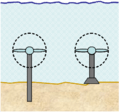Tidal stream power facts for kids
Tidal stream power is a way to make electricity using the natural movement of ocean tides. Imagine a big machine, called a tidal stream generator. It takes energy from the moving water. It works a lot like how a wind turbine gets energy from moving air.
This type of power is often the cheapest and causes the least harm to nature compared to other ways of making tidal energy.
Tidal stream power is a fairly new idea. People first thought of it in the 1970s, when there was a big problem with oil supply.
Contents
How Tidal Turbines Work
A single tidal turbine can make more power than a wind turbine of the same size. This is because water is about 800 times heavier than air. So, moving water pushes much harder on a turbine than moving air does, even at the same speed.
Also, water doesn't need to move as fast as wind for a power project to be useful. For a tidal turbine to work well, the water usually needs to move at least 2 knots (about 1 meter per second). This speed is needed even during neap tides, which are when tides are weakest.
Finding the Best Spots for Tidal Power
Just like with wind power, picking the right place for a tidal turbine is super important. Tidal stream systems need to be in areas where water currents are very strong. These strong currents often happen where water is squeezed between land.
Good places include:
- Entrances to bays and rivers.
- Around rocky points or headlands.
- Between islands or other land masses.
Impact on the Environment
One big worry about tidal turbines is whether they might hurt or kill fish. There hasn't been a lot of research directly watching how tidal stream systems affect nature. Most studies involve releasing tagged fish and seeing if they are harmed.
Studying Fish Safety
One study looked at the Roosevelt Island Tidal Energy (RITE) project in New York City. Scientists used special sound sensors to track fish movement. They watched fish both upstream and downstream of six turbines.
The study found a few things:
- Not many fish were using that part of the river.
- The fish that were there mostly stayed away from the turbine blades.
- There was no proof that fish were swimming through the blade areas.
More work is being done by the Northwest National Marine Renewable Energy Center (NNMREC). They are creating ways to check and track changes in the environment around tidal energy projects.
Images for kids





